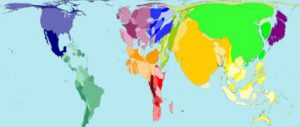[Produced in association with Rutgers Climate and Social Policy Initiative]
The Kyoto Protocol and the future agreement that has been emerging since the Bali conference divide the over 6 billion inhabitants of the world – and more than 200 countries – into two groups: developed and developing. This has misled Chinese politicians into believing their country will always be a developing nation. In fact, China is not a developing nation in the typical sense. It is a country that is constantly making progress.
There are two factors that will force China to commit to emission reductions. First, the bulk of China’s population are already in the High, or Medium-high, Human Development Index (HDI) groups (see part one). Around 20 years ago, the majority were in the lower two groups. Figures from 2003 show that China is no longer a typical developing nation: 20% of its population is in the High HDI group and 75% in the Medium-high group. Analysing China’s 31 provincial-level divisions uncovers levels of human development that span the entire HDI spectrum. However, in the last two decades, China’s population has moved from primarily occupying the lowest two groups to the highest two.
This paper estimates that by 2010, 42% of China’s population will be in the High HDI group. By 2020, although China’s per-capita GDP will only have reached the world average, its HDI will be 0.87 or 0.88. Overall, China will be in the High HDI group. This reflects one of the characteristics of China’s growth: relatively low per-head income in comparison with developed nations, yet high living standards. China will have the ability to undertake emissions reduction commitments.
It is possible to calculate net carbon sources for each province, autonomous region and municipality in China by looking at sources of carbon emissions and at sequestration. One group in particular – comprising the provinces of Zhejiang, Liaoning, Guangdong and Jiangsu – accounts for 21.42% of China’s net carbon sources, and is also in the High HDI group of non-conditional emissions reducers. Therefore, these four provinces should cut their emissions, and to a far higher degree than is called for by the global road map. An initial plan would be to set these radical targets for the provinces:
•Aim for carbon emissions to peak by 2012;
•From 2020 to begin reducing carbon emissions to 1990 levels;
•By 2030 to reduce carbon emissions to half 1990 levels.
The three municipalities of Shanghai, Beijing and Tianjin account for 5.78% of total carbon sources and are also in the High HDI group. They should also reduce emissions in line with global proposals.
A second camp, comprising the provinces of Hebei, Shandong, Shanxi, Henan, Hubei and Hunan, account for 48.89% of total carbon sources and are therefore major emitters. However, they have medium HDI levels, and are therefore only conditional reducers. The degree of cuts would be determined by their contribution to national carbon sources, and their distance from the 0.8 HDI threshold.
A third camp, Yunnan, Qinghai and Tibet, have negative net carbon emissions. Their carbon emissions account for 2.23% of the total for other provinces, and these areas should receive environmental subsidies from those areas.
The remaining 15 areas, except Guizhou, are all in the Medium-high HDI group and as such should be conditional emissions reducers. As their HDI figures pass the 0.8 threshold they will become non-conditional reducers.
The Stern Review put global average carbon emissions per head at seven tonnes. Figures for developed nations range from 10 tonnes for Japan to 22 tonnes for the United States. Developing nations range from insignificant emissions in the poorest nations, to two tonnes in India and six tonnes in China. With the world’s population on course to reach nine billion, by 2050 the average carbon emissions per capita should be two tonnes.
The World Bank puts China’s per capita carbon emissions for 1990, 2000 and 2006 at 2.1, 2.6 and 3.9 tonnes respectively, compared to the global averages of 4.1, 4.0 and 4.3 tonnes. According to China’s road map, the country could see per-capita emissions peak by 2020. If China’s population reaches 1.4 billion in 2050, per-capita emissions would be at the 1990 level of two tonnes, or lower.
The second factor forcing China’s hand is its status as the world’s second-largest emitter of carbon dioxide. Figures from the UNDP show China accounted for 17.28% of global CO2 emissions in 2004. The International Energy Agency calculates this will be 27.32% in 2030, making China the largest emitter. The country is already the world’s most populous nation and its third-largest economy. But it is also the biggest source of sulphur dioxide (SO2) emissions, the largest coal consumer and the second largest energy consumer. China is one of the world’s largest polluters, and it has a responsibility to reduce those emissions.
These two factors mean that China must accept responsibilities. The current leadership has not realised this and taken these facts into full consideration. Decisions on international climate-change policy are suffering from a lack of information. If China’s leaders were clearer about the dangers of climate change and the country’s stance, they would be clearer about the obligations. If China is not clear about its responsibilities, and short-sighted enough to not make commitments at Copenhagen, India will follow suit. And if these two nations, accounting for 20% of total emissions, do not participate, EU efforts will be to no avail.
Towards an agreement
China has made three major contributions to the world since the start of the reform era: growth in the global economy, growth in global trade and huge poverty reduction. The world has already acknowledged these contributions, particularly in the area of poverty reduction.
In 2007, president Hu Jintao said that by 2020 China would be more open to the world and make a greater contribution to civilization. In the coming decades China needs to make that contribution an environmental one; and its largest contribution to humanity in the new century. China should lead developing nations in reducing emissions; become the largest planter of carbon-sink forests; publish a road map for emission reductions; and strive to halve emissions in 1990 by 2050.
In the short term, the Chinese leadership should use the opportunity of the Copenhagen conference to adopt emissions reductions and publish a timetable for doing so. This will promote a global agreement and China will become a leader in global governance.
In the long term, China’s leaders should view emissions reductions and the transition to a low-carbon economy in terms of the best interests of humanity, leading the nation toward economic and governmental transformation and making a further contribution towards human development.
Hu Angang is one of China’s best-known economists. He is professor at the Chinese Academy of Sciences and Tsinghua University and the director of the Centre for China Study, a leading policy think-tank. Hu has worked as the chief editor for China Studies Report, a circulated reference for senior officials.
Guan Qingyou, PhD, from the Centre for China Studies, contributed to this article.
Produced in association with:
Homepage photo by Squiggle


